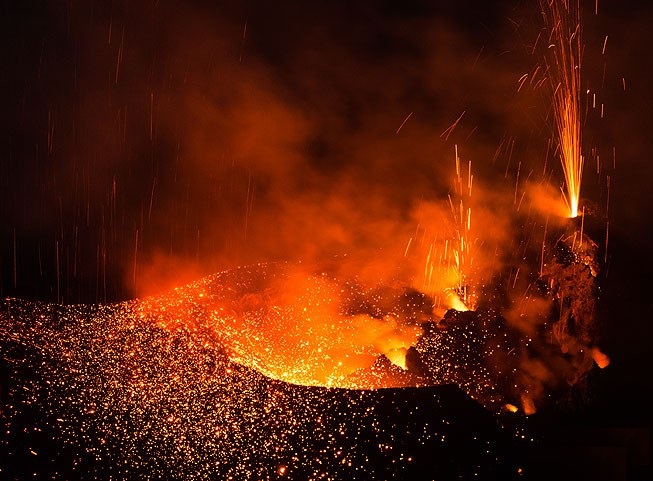- 작성일
- 2014.06.22
- 수정일
- 2014.06.22
- 작성자
- 윤성효
- 조회수
- 320
2014년 6월 9-10일 스트롬볼리 화산의 분화
Strombolian eruptions are relatively low-level volcanic eruptions, named after the Italian volcano Stromboli, where such eruptions consist of ejection of incandescent cinder, lapilli and lava bombs to altitudes of tens to hundreds of meters. They are small to medium in volume, with sporadic violence.
They are defined as "...Mildly explosive at discrete but fairly regular intervals of seconds to minutes..."
The tephra typically glows red when leaving the vent, but its surface cools and assumes a dark to black color and may significantly solidify before impact. The tephra accumulates in the vicinity of the vent, forming a cinder cone. Cinder is the most common product; the amount of volcanic ash is typically rather minor.
The lava flows are more viscous, and therefore shorter and thicker, than the corresponding Hawaiian eruptions; it may or may not be accompanied by production of pyroclastic rock.
Instead the gas coalesces into bubbles, called gas slugs, that grow large enough to rise through the magma column, bursting near the top due to the decrease in pressure and throwing magma into the air.
Each episode thus releases volcanic gases, sometimes as frequently as a few minutes apart. Gas slugs can form as deep as 3 kilometers, making them difficult to predict.
Strombolian eruptive activity can be very long-lasting because the conduit system is not strongly affected by the eruptive activity, so that the eruptive system can repeatedly reset itself. For example, the Par?cutin volcano erupted continuously between 1943-1952, Mount Erebus, Antarctica has produced Strombolian eruptions for at least many decades, and Stromboli itself has been producing Strombolian eruptions for over two thousand years. The Romans referred to Stromboli as the "Lighthouse of the Mediterranean."
They are defined as "...Mildly explosive at discrete but fairly regular intervals of seconds to minutes..."
The tephra typically glows red when leaving the vent, but its surface cools and assumes a dark to black color and may significantly solidify before impact. The tephra accumulates in the vicinity of the vent, forming a cinder cone. Cinder is the most common product; the amount of volcanic ash is typically rather minor.
The lava flows are more viscous, and therefore shorter and thicker, than the corresponding Hawaiian eruptions; it may or may not be accompanied by production of pyroclastic rock.
Instead the gas coalesces into bubbles, called gas slugs, that grow large enough to rise through the magma column, bursting near the top due to the decrease in pressure and throwing magma into the air.
Each episode thus releases volcanic gases, sometimes as frequently as a few minutes apart. Gas slugs can form as deep as 3 kilometers, making them difficult to predict.
Strombolian eruptive activity can be very long-lasting because the conduit system is not strongly affected by the eruptive activity, so that the eruptive system can repeatedly reset itself. For example, the Par?cutin volcano erupted continuously between 1943-1952, Mount Erebus, Antarctica has produced Strombolian eruptions for at least many decades, and Stromboli itself has been producing Strombolian eruptions for over two thousand years. The Romans referred to Stromboli as the "Lighthouse of the Mediterranean."

- 첨부파일